

Śruti. Śhruti (Sanskrit: श्रुति, IAST: śrúti, lit.
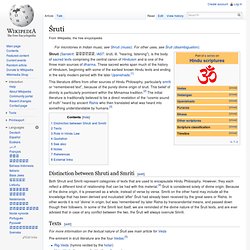
Yajna. A yajna being performed.
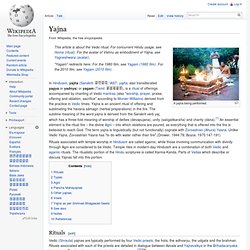
In Hinduism, yajña (Sanskrit: यज्ञ; IAST: yajña, also transliterated yagya or yadnya) or yagam (Tamil: யாகம்), is a ritual of offerings accompanied by chanting of Vedic mantras (also "worship, prayer, praise, offering and oblation, sacrifice" according to Monier-Williams) derived from the practice in Vedic times. Yajna is an ancient ritual of offering and sublimating the havana sámagri (herbal preparations) in the fire.
The sublime meaning of the word yajna is derived from the Sanskrit verb yaj, which has a three-fold meaning of worship of deities (devapujana), unity (saògatikaraña) and charity (dána).[1] An essential element is the ritual fire – the divine Agni – into which oblations are poured, as everything that is offered into the fire is believed to reach God. The term yajna is linguistically (but not functionally) cognate with Zoroastrian (Ahura) Yasna. Unlike Vedic Yajna, Zoroastrian Yasna has "to do with water rather than fire". Vedic priesthood. Priests of the Vedic religion are officiants of the yajna service.
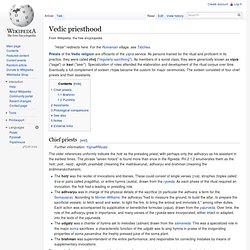
As persons trained for the ritual and proficient in its practice, they were called ṛtvij ("regularly-sacrificing"). As members of a social class, they were generically known as vipra ("sage") or kavi ("seer"). Vedic priesthood. Priests of the Vedic religion are officiants of the yajna service.
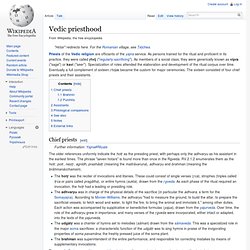
As persons trained for the ritual and proficient in its practice, they were called ṛtvij ("regularly-sacrificing"). As members of a social class, they were generically known as vipra ("sage") or kavi ("seer"). Specialization of roles attended the elaboration and development of the ritual corpus over time. Eventually a full complement of sixteen ṛtvijas became the custom for major ceremonies. Shudra. See also[edit] Caste system in India.
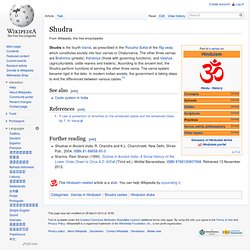
Kshatriya. The Sanskrit term Kshatriya belonged to the Vedic society wherein members organized themselves into 3 classes: Brahmin, Kshatriya, and Vaishya.[1] Traditionally, Kshatriya constitute the ruling and military elite.
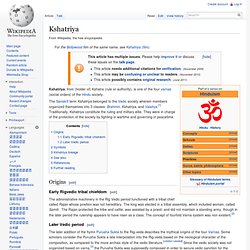
They were in charge of the protection of the society by fighting in wartime and governing in peacetime. Origins[edit] Early Rigvedic tribal chiefdom[edit] The administrative machinery in the Rig Vedic period functioned with a tribal chief called Rajan whose position was not hereditary. The king was elected in a tribal assembly, which included women, called Samiti . Later Vedic period[edit] The term Kshatriya comes from Kshatra and implies temporal authority and power which was based less on being a successful leader in battle and more on the tangible power of laying claim to sovereignty over a territory, and symbolizing ownership over clan lands.
Vaishya. Traditional duties[edit] Hindu religious texts assigned Vaishyas to traditional roles in agriculture and cattle-rearing but over time they came to be landowners, traders and money-lenders.[1] The Vaishyas, along with members of the Brahmin and Kshatriya varnas, claim "twice born" (dvija) status in Hindu theology.[2] Indian traders were widely credited for the spread of Indian culture to regions as far as southeast Asia.[3] Historically, Vaishyas have been involved in roles other than their traditional pastoralism, trade and commerce.
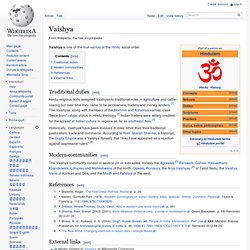
According to Ram Sharan Sharma, a historian, the Gupta Empire was a Vaishya dynasty that "may have appeared as a reaction against oppressive rulers".[4] Modern communities[edit] References[edit] External links[edit] Vedic Literature. Rig Veda The Rig veda has a collection of 10472 riks(mantras)with valakhilya sookta comprising of 80 mantras.this is the oldest form of knowledge in the world today.The Riks are the collection of lyrics in praise of different Gods ,recited by the priests known as HOTA.Special exphasis is laid on soul’s awakening,It has universal appeal:” Let all men meet and think as with one mind.Let all hearts unite in Love.Let the goal be common.May all live in happiness with common purpose”SageRishi Paila has composed this veda under the instructions of Bhagavan Vyasa.

Vedics who have mastered Rig veda tatva ,HOTAS can perform yagas and homas. Rudra. Rudra, "a storm god and embodiment of wildness and unpredictable danger", from a 19th-century textbook on Hinduism Rudra (Devanagari: रुद्र) is a Rigvedic deity, associated with wind or storm,[1] and the hunt.
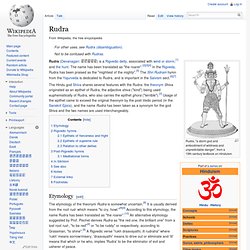
Brahman. Not to be confused with Brahma, the Hindu god, or brahmin, the caste or varna.

In Hinduism, Brahman (/ˈbrɑːmən/; Sanskrit: ब्रह्मन् brahman) is "the unchanging reality amidst and beyond the world",[1] which "cannot be exactly defined". It has been described in Sanskrit as Sat-cit-ānanda (being-consciousness-bliss) and as the highest reality. [note 1][note 2] Samhita. Yajna. Jnana. Jnana or gnana or gnaan (Sanskrit; Pali: jñāna) is a Sanskrit word that means knowledge. It has various nuances of meaning depending on the context, and is used in a number of different Indian religions. The idea of jnana centers around a cognitive event which is recognized when experienced.[1] It is knowledge inseparable from the total experience of reality, especially a total reality,[1] or supreme being within Mahesha-dhama (and/or material world) such as Siva-Sakti.[2] Absence of jnana (knowledge, gnosticism) is known as ajnana (see: agnosticism): Famous mantra in this relationship says: "Om ajnana timirandhasya...
" (I was born in ajnana, agnosticism, but my spiritual master opened my eyes with fire of transcendental knowledge, jnana). Max Müller. Friedrich Max Müller (December 6, 1823 – October 28, 1900), generally known as Max Müller, was a German-born philologist and Orientalist, who lived and studied in Britain for most of his life. He was one of the founders of the western academic field of Indian studies and the discipline of comparative religion.[1] Müller wrote both scholarly and popular works on the subject of Indology and the Sacred Books of the East, a 50-volume set of English translations, was prepared under his direction.
He also put forward and promoted the idea of a Turanian family of languages and Turanian people. Early life and education[edit] Friedrich Max Müller was born on 6 December 1823 in Dessau, the son of Wilhelm Müller, a lyric poet whose verse Franz Schubert had set to music in his song-cycles Die schöne Müllerin and Winterreise. His mother, Adelheid Müller (née von Basedow), was the eldest daughter of a prime minister of Anhalt-Dessau. Vāc. Vāk or Vāc (stem vāc-, nominative vāk) is the Sanskrit word for "speech", from a verbal root vac- "speak, tell, utter". Personified, Vāk is a goddess; in the Veda she is also represented as created by Prajapati and married to him; in other places she is called the "mother of the Vedas" and wife of Indra.[1][2] In Hinduism, she is identified with Bharati or Sarasvati. Rigveda[edit] In the early Rigveda (books 2 to 7), vāc- refers to the voice, in particularly the voice of the priest raised in sacrifice.
She is personified only RV 8 and RV 10, in RV 10.125.5 speaking in the first person (trans. Griffith), Wiki: Historical Vedic religion.